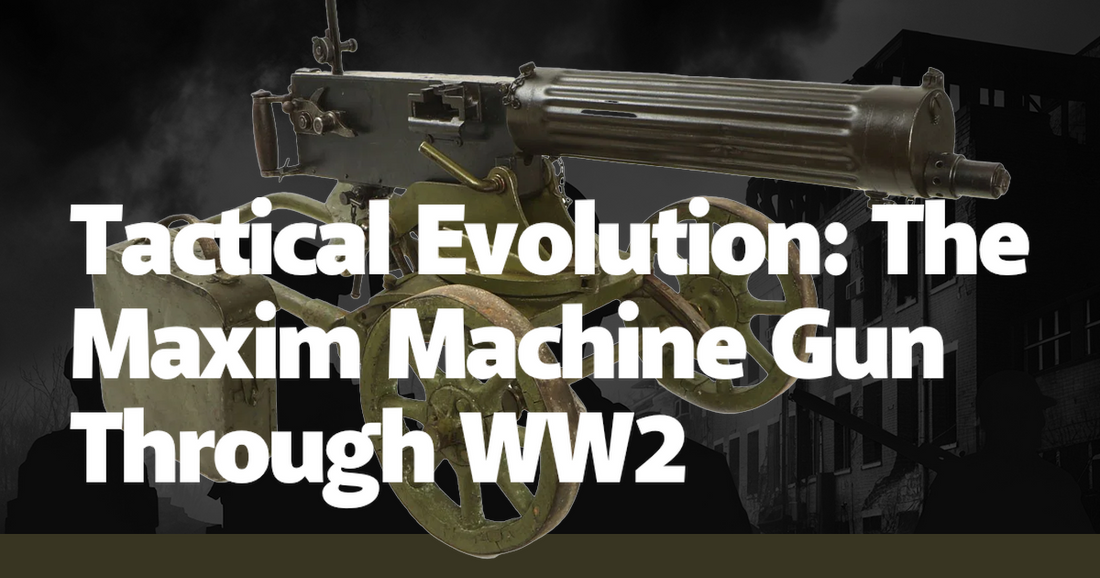The dawn of the Maxim machine gun in the late 19th century marked a seismic shift in military tactics and the nature of warfare itself. Invented by Sir Hiram Stevens Maxim in 1884, the Maxim was the first fully automatic machine gun, a marvel of engineering that harnessed the energy of recoil to continuously chamber and fire rounds. This innovation transformed the battlefield, introducing an era where the volume of fire could decisively alter the course of engagements. The Maxim's ability to sustain a high rate of fire without manual intervention meant that a single gunner could unleash a torrent of bullets, effectively replacing the firepower of multiple riflemen and rendering traditional infantry charges obsolete.
During the First World War, the Maxim machine gun entrenched itself as a symbol of the new mechanized slaughter. On the Western Front, the Maxim's role was both strategic and psychological. Dug into fortified positions, these guns created lethal zones of interlocking fire that decimated waves of advancing troops. The Battle of the Somme in 1916 stands as a grim testament to this, where British forces suffered nearly 60,000 casualties on the first day, many mowed down by German MG 08s, a variant of the Maxim. The sheer destructive power of these guns forced military tacticians to rethink offensive strategies, leading to the development of trench warfare, where the goal was to outmaneuver and outlast the enemy rather than to advance through direct assault.
Between the wars, the Maxim machine gun continued to evolve, adapting to the changing demands of modern combat. Various nations produced their own versions, each with incremental improvements in reliability and ease of use. The Soviet Union's PM M1910, for instance, became a staple of Red Army firepower, featuring a distinctive wheeled mount for mobility. This period also saw the integration of the machine gun into combined arms tactics, where it was used in conjunction with artillery, tanks, and infantry to create a cohesive and flexible fighting force. The lessons learned from the brutal trench warfare of WWI informed these developments, emphasizing the need for mobility and coordination over static defense.
As World War II erupted, the Maxim machine gun once again took center stage, though now it was part of a more diverse arsenal of automatic weapons. The German MG 34 and MG 42, though not direct descendants of the Maxim, owed much to its pioneering design principles. These newer models offered even higher rates of fire and were more versatile in various combat scenarios, from defensive emplacements to mobile assaults. However, the Maxim still saw extensive use, particularly on the Eastern Front. The Soviet Union, in desperate need of reliable weaponry, continued to deploy the PM M1910, which proved invaluable in the harsh winter conditions where more modern firearms sometimes faltered.
One notable engagement highlighting the Maxim's enduring utility was the Battle of Stalingrad. Here, Soviet defenders utilized the PM M1910 to devastating effect, setting up interlocking fields of fire that turned the urban landscape into a deadly maze for the invading German forces. The Maxim's robust construction and water-cooled barrel allowed it to fire continuously without overheating, a critical advantage during the prolonged and intense firefights that characterized the battle. These machine guns were often positioned in concealed locations, such as the ruins of buildings, creating deadly ambush points that inflicted heavy casualties on the Germans and contributed significantly to the eventual Soviet victory.
The Maxim machine gun's influence extended beyond its immediate battlefield impact; it also shaped military doctrine and training. The concept of suppressive fire, where machine guns are used to pin down enemy forces and prevent their movement, became a cornerstone of infantry tactics. This approach was evident in the training manuals and field exercises of numerous armies, who recognized that the ability to control the battlefield with sustained fire could create opportunities for maneuver and assault. The Maxim's legacy thus lies not only in its direct contributions to combat but also in its role in teaching military leaders the value of firepower coordination and tactical flexibility.
In the broader context of technological innovation, the Maxim machine gun represents a pivotal moment in the mechanization of warfare. Its introduction marked the beginning of a trend towards increasingly sophisticated and deadly weaponry, a trajectory that would continue through the 20th century and beyond. The principles of automatic fire and recoil operation pioneered by Hiram Maxim laid the groundwork for future developments in firearms technology, influencing everything from light machine guns to modern assault rifles. The Maxim's enduring presence on the battlefield, even as newer weapons emerged, underscores its revolutionary design and the profound impact it had on military strategy and tactics.
Reflecting on the tactical evolution of the Maxim machine gun through World War II, it is clear that this weapon was more than just a tool of destruction; it was a catalyst for change in the way wars were fought. From its inception in the late 19th century to its prominent role in two world wars, the Maxim machine gun exemplifies the relentless march of military innovation and the ever-increasing complexity of armed conflict. Its story is one of adaptation and resilience, a testament to the ingenuity of its design and the enduring relevance of its core principles in the face of evolving technological and tactical landscapes. The Maxim machine gun, in its many forms, remains a symbol of the profound transformations that have shaped modern warfare.

